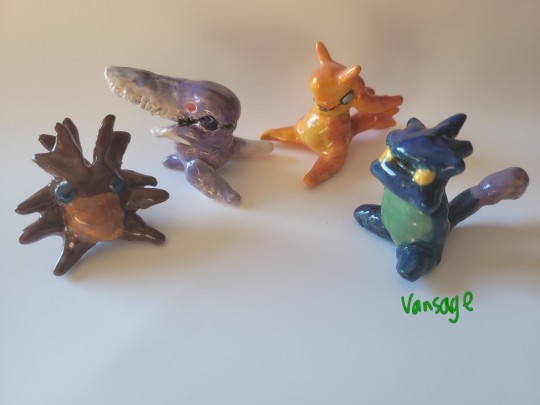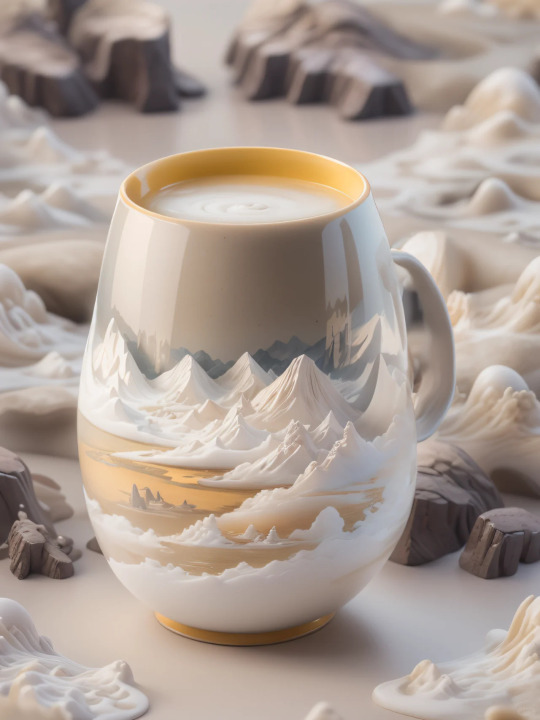#advanced ceramic
Explore tagged Tumblr posts
Text

The Djinn from Golden Sun.
I couldn't mix the underglaze well.
#golden sun#ceramic#clay#ceramics#my art#art#gameboy advance#golden sun is over 23 years old wow#im younger than it#3d art
78 notes
·
View notes
Text
searching "how silicone is made" for. uh. absolutely no reason at all.
#I do not think I can justify the noldor producing synthetic polymers#if for no other reason than they are extremely useful#and would be used for more applications than this#and putting plastic into middle earth/valinor is not really something I want to try to figure out for a BUNCH of reasons#I was already leaning against it but medical grade silicone is SO nice for certain things I had to check.#luckily I feel I can justify pretty much any super advanced glass metal or ceramic work yay
19 notes
·
View notes
Text
really annoying being in art school as someone as skilled as me. in photography class he was telling us that when were taking portraits that we shouldnt set the light source behind the person and im sorry but if you cant realize that yourself you might be a little helpless
#maybe thats a mean thing to say but come on#also i might be a little less annoyed if we didnt do like zoom meetings with no visuals#no visuals in an art class can you imagine?#cool thing your talking about about this visual medium#wish i could see it#ugh#anyways im doing advanced classes and ceramics next semester so thats exciting
23 notes
·
View notes
Text
Advanced Ceramics Market Size, Share Forecast & Geographic Focus 2029

In a world driven by high-performance technologies, traditional materials often fall short. This is where advanced ceramics come into play—bringing superior strength, thermal stability, and corrosion resistance to the table. Once confined to niche scientific applications, these engineered materials are now at the heart of sectors like electronics, automotive, medical, defense, and energy.
The global advanced ceramics market is undergoing a significant transformation. With sustainability, miniaturization, and performance at the forefront of industrial demands, manufacturers and end-users alike are leaning into the unmatched capabilities of advanced ceramics. The market is projected to reach USD 16.27 billion by 2029 from USD 12.16 billion in 2024, at a CAGR of 6.0%, driven by technological advancements and rising applications across various sectors.
What Are Advanced Ceramics?
Advanced ceramics are a class of materials that go beyond traditional clay-based ceramics. Made from highly purified and specially formulated raw materials such as alumina, zirconia, silicon carbide, and titanium dioxide, these ceramics offer superior properties:
High mechanical strength
Excellent wear and corrosion resistance
Exceptional thermal and electrical insulation
Biocompatibility for medical use
Lightweight with high durability
These properties make advanced ceramics indispensable in critical environments where performance is non-negotiable.
Key Market Drivers
1. Electronics & Semiconductors Boom
The electronics industry is one of the most significant consumers of advanced ceramics. Components such as insulators, capacitors, substrates, and sensors rely heavily on the insulating and heat-resistant properties of these materials. As demand for smaller, faster, and more reliable devices grows, ceramic substrates and heat sinks are becoming essential in high-frequency and power electronics.
2. Rising Electric Vehicle (EV) Adoption
The global shift toward electric mobility is a major growth catalyst. Advanced ceramics are used in EV batteries, sensors, braking systems, and thermal management components. Their ability to withstand high temperatures and mechanical stress makes them ideal for the high-performance demands of EVs.
3. Healthcare Advancements
From orthopedic implants and dental prosthetics to surgical instruments, biocompatible ceramics like zirconia and alumina are revolutionizing healthcare. Their inert nature and compatibility with the human body have made them a preferred choice in critical applications. With healthcare technology constantly evolving, the role of advanced ceramics is only set to expand.
4. Energy & Environmental Applications
Advanced ceramics are increasingly used in renewable energy systems, such as solid oxide fuel cells (SOFCs), solar panels, and wind turbines. Their resistance to extreme temperatures and corrosion makes them ideal for energy-efficient and long-lasting solutions. Additionally, they are also used in filtration systems, helping industries reduce environmental impact.
Market Challenges to Watch
While the outlook is promising, there are hurdles to overcome:
High production costs due to complex manufacturing processes
Brittleness in some ceramic compositions under certain mechanical stress
Limited recyclability, making end-of-life management a concern
However, ongoing R&D is paving the way for innovations that can address these challenges, including the development of tougher ceramics and cost-effective fabrication techniques.
Leading Players in the Market
The market is fairly consolidated, with a few key players driving innovation:
Kyocera Corporation – Known for its electronic components and ceramic-based solutions.
3M – Offers ceramics for filtration, electronics, and advanced coatings.
CoorsTek Inc. – A major player in industrial ceramics across multiple applications.
Morgan Advanced Materials – Specializes in engineered ceramics for energy, defense, and healthcare sectors.
CeramTec GmbH – Leading in medical and industrial ceramic components.
Regional Landscape
Asia Pacific holds the lion’s share of the market, led by countries like China, Japan, and South Korea. Rapid industrialization, growing electronics manufacturing, and government investments in healthcare and EV infrastructure are driving growth in this region. North America and Europe follow closely, with a strong focus on innovation and environmental compliance.
Explore the full report – Download the PDF brochure now.
The advanced ceramics market is no longer a quiet niche. It’s becoming a vital backbone for industries requiring materials that outperform metals and polymers. Whether it's for boosting energy efficiency, ensuring medical safety, or enabling next-gen electronics, advanced ceramics are powering the technologies of tomorrow.
#Advanced Ceramics#High Performance Materials#Ceramic Components#EV Materials#Electronic Ceramics#Medical Ceramics#Sustainable Manufacturing
1 note
·
View note
Text

ok the problem now. is only having two three hour blocks and a general lack of experience with which to tackle any of this
5 notes
·
View notes
Text








Design: Chinese ceramic water cup, what do you want to drink from it~ Soak wolfberry in warm water or boil it in cold water?
#appearancewatercup#appearancecup#I’m a cup control#ceramic cup#mug#a water cup that lets you drink water with an accent#cup sharing#AIGC#Advanced Feeling color matching
2 notes
·
View notes
Text
A Market Research and Competitive Intelligence Provider: The global dental 3dimensional (3D) printing market is estimated to reach US$ 3 billion in 2023 and accelerate at an astonishing 22% CAGR from 2023 to 2033. The revenue generated from the market is expected to result in a valuation of US$ 21.9 billion by 2033.
#advanced 3D dental printers#dental 3D printing Companies#tooth 3D printing materials#ceramic dental 3D printing
1 note
·
View note
Text
starting my sophomore year of college tmrw…
#sorry i’m advance for both radio silence and also future vent posts </3#i’m excited and also a little nauseous#at least i have ceramics mon/wed!!!!!#txt
2 notes
·
View notes
Text
#Advanced Structural Ceramics Market#Advanced Structural Ceramics Market Size#Advanced Structural Ceramics Market Share#Advanced Structural Ceramics Market Growth
0 notes
Text
Advanced Ceramics Market Anticipated to Hit USD 176.84 Billion by 2034 | CAGR: 4.3%
The global advanced ceramics market was valued at USD 116.68 billion in 2024 and is expected to grow from USD 121.50 billion in 2025 to USD 176.84 billion by 2034, registering a CAGR of 4.3% during the forecast period. Advanced Ceramics Market Key Trends & Insights: Growing demand in electronics and semiconductors is driving the use of advanced ceramics for high thermal stability and…
#Advanced Ceramics Market Growth#Advanced Ceramics Market Share#Advanced Ceramics Market Size#Advanced Ceramics Market Trends
0 notes
Text
Multi-Layer Car Coating
Protecting your car’s exterior is no longer just about a wax job or a simple clear coat. In today’s advanced automotive detailing industry, multi-layer car coating systems are becoming the gold standard for superior paint protection, depth of shine, and long-term durability. multi-layer car coating What Is a Multi-Layer Car Coating? A multi-layer car coating involves applying multiple…
#advanced car paint protection#ceramic coating layers#long-lasting car coating system#multi-layer car coating#professional car coating services
1 note
·
View note
Text
0 notes
Text
Advanced Ceramics Industry Outlook: Unpacking Market Size & Future Opportunities

Advanced Ceramics stands as a cornerstone of modern technological progress, silently powering innovations across a vast spectrum of sectors. Unlike traditional ceramics, these engineered materials boast exceptional properties such as extreme hardness, high-temperature resistance, excellent electrical insulation, and superior chemical inertness, making them indispensable for demanding applications. Indeed, the Advanced Ceramics Industry is a critical enabler of cutting-edge solutions, consistently pushing the boundaries of material science and driving industrial advancements worldwide. From revolutionizing electronics and medical devices to enhancing performance in aerospace, automotive, and renewable energy, its impact is profound and continuously expanding..
What Are Advanced Ceramics?
Advanced ceramics, sometimes referred to as technical or engineered ceramics, are highly refined, non-metallic materials known for their strength, hardness, high-temperature resistance, corrosion resistance, and electrical insulation. Common examples include alumina (Al₂O₃), zirconia (ZrO₂), silicon carbide (SiC), and silicon nitride (Si₃N₄). These ceramics are processed through advanced manufacturing methods like powder metallurgy and sintering, resulting in materials that outperform metals and polymers in harsh environments.
Applications That Define Tomorrow
1. Electronics & Semiconductors Advanced ceramics are critical in the miniaturization and performance of modern electronics. Their insulating properties make them ideal for substrates, capacitors, and insulators in smartphones, sensors, and semiconductor devices.
2. Aerospace & Defense In aerospace, materials must endure extreme temperatures, pressure, and stress. Silicon carbide and silicon nitride are used in thermal barriers, engine components, and ballistic armor due to their strength-to-weight ratio and high heat resistance.
3. Automotive Ceramic parts are used in engine components, braking systems, and sensors. For instance, zirconia oxygen sensors are crucial in fuel control systems, enhancing efficiency and lowering emissions.
4. Healthcare & Biotechnology The biocompatibility of certain ceramics like zirconia and alumina makes them ideal for dental implants, joint replacements, and prosthetics. Their resistance to wear and chemical degradation ensures long-term functionality inside the human body.
5. Renewable Energy Advanced ceramics play a role in solid oxide fuel cells (SOFCs), wind turbines, and solar panels. Their durability in high-heat and chemically reactive environments makes them essential for clean energy systems.
Why It Matters: Strategic Value for Industry Leaders
For decision-makers, the adoption of advanced ceramics offers both performance advantages and long-term cost efficiency. While initial production costs may be higher than traditional materials, the longevity, resistance to wear, and reduced maintenance make advanced ceramics a strategic asset in high-value applications.
Key strategic benefits:
Extended product lifecycle
Reduced downtime and maintenance
Lightweight alternatives to metal parts
Enhanced energy efficiency in thermal systems
Compliance with sustainability and performance regulations
Opportunities
3D printing and additive manufacturing of ceramics
Nanostructured ceramic materials
Ceramic composites for multifunctional applications
Recyclable and eco-friendly ceramic production
Universities and research institutions around the globe are investing in ceramic R&D, and industries are actively seeking talent with expertise in advanced ceramics for product development and process optimization.
Challenges Ahead
Despite the exciting opportunities, there are challenges to address:
Brittleness: Though strong, ceramics can fracture under tensile stress.
Processing complexity: High temperatures and precise processing control are required.
Cost: Initial production can be more expensive than metals or polymers.
Yet, innovation in composite ceramics and manufacturing techniques is helping to mitigate these issues, expanding their industrial use.
Download Report PDF :
From smartphones to spacecrafts, advanced ceramics are reshaping how we build, heal, move, and connect. For students, the field offers a promising career path. For experts, it continues to unlock technical frontiers. And for business leaders, it presents an opportunity to future-proof products and processes with materials that redefine performance.
#advanced ceramics#ceramic materials#aerospace ceramics#ceramic applications#technical ceramics#ceramic manufacturing#high-performance materials
0 notes
Text
Minmetals East: Elevating the Chemical Manufacturing Industry
Are you interested in innovative solutions in the chemical manufacturing sector? Minmetals East is leading the way with its exceptional range of industrial materials, including high-quality silica products and advanced adhesives. Our ceramic fibre modules are designed to enhance efficiency and performance in various applications, particularly in construction materials and water treatment.
We invite everyone to share their experiences or insights regarding the use of ceramic fibre modules. What benefits have you noticed? Are there specific applications where they've made a significant impact? Join the conversation and let’s explore the possibilities together! Your input could help others make informed decisions.
Together, we can continue to elevate our industry standards and embrace the positive changes that innovative materials bring!
#industry standards#industrial materials#advanced adhesives#water treatment#chemical manufacturing#ceramic fibre modules#construction materials#efficiency
0 notes
Text
Exploring the Benefits of ZrO2 Powder in Chemical Manufacturing
In the ever-evolving landscape of chemical manufacturing, the role of ZrO2 powder is gaining significant attention, particularly in industries such as industrial materials, silica products, adhesives, construction materials, and water treatment. Minmetals East stands out as a leader in providing high-quality ZrO2 powder, which is known for its exceptional properties and versatility.
ZrO2 powder, or zirconium dioxide, is celebrated for its high thermal stability, mechanical strength, and resistance to chemical corrosion. This makes it an ideal choice for various applications, including advanced ceramics, dental materials, and even in the production of adhesives that require high durability.
Moreover, in the construction materials sector, ZrO2 powder enhances the performance of concrete and other building materials, contributing to sustainable construction practices. Its incorporation into water treatment processes also showcases its ability to improve filtration and purification methods, ensuring cleaner water for communities.
Minmetals East not only provides top-notch ZrO2 powder but also emphasizes innovation and sustainability in all its products. Their commitment to quality and customer satisfaction makes them a trusted partner in the chemical manufacturing industry. If you're looking to enhance your products or processes, consider the benefits of integrating ZrO2 powder from Minmetals East into your operations.
#innovation#industrial materials#chemical manufacturing#advanced ceramics#zirconium dioxide#Minmetals East#purification#adhesives
0 notes